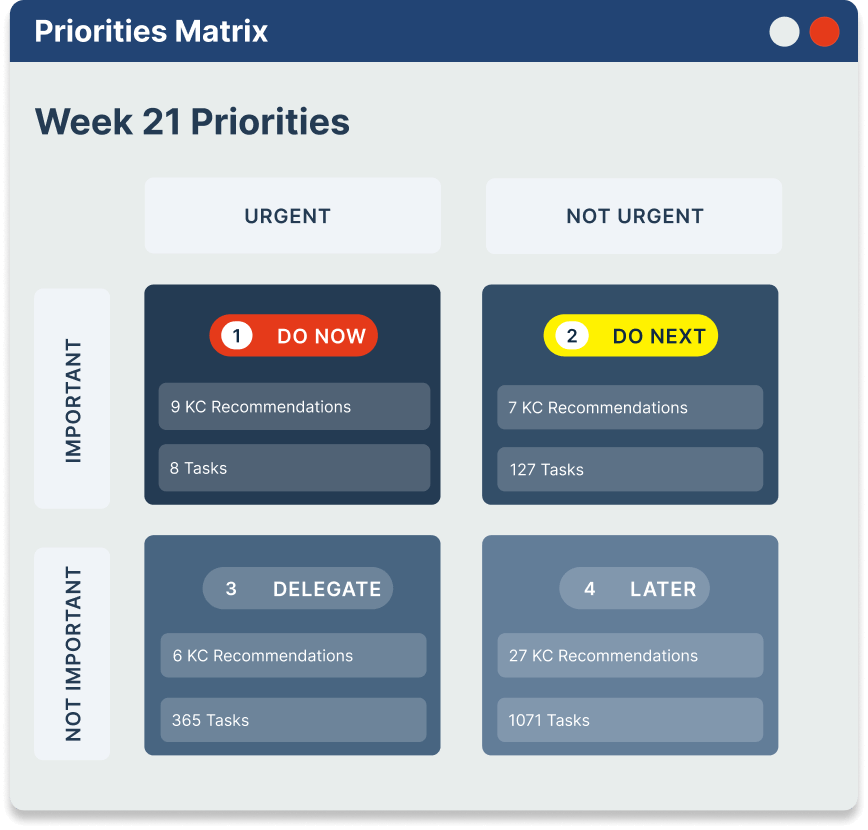Keep Your Projects on Track: The Priorities Matrix Approach
At Foresight Works, one of our biggest mantras is, “Time is money.” Yes, it’s a tad cliche but it’s also extremely relevant to our customers and the work they do.
As we’ve mentioned in previous blog posts, too many project teams put all their focus into controlling costs (such as resources and materials) while ignoring the value of time. This can lead to delays that cost millions of dollars per day. So, you see, time really is money.
In this blog post, we’ll explore the essential role that prioritization plays in preventing delays and how our Priorities Matrix can help you stay on track.
Why Are Project Delays So Common?
One of the biggest challenges our customers face is not knowing what they need to focus on to get the job done. They are constantly asking themselves, “What do we need to prioritize this month or this week to meet our deadline?” This often results in teams propritizing things that are comfortable or familiar to them — even if they are not actually a priority.
Sound familiar?
Most organizations lack an objective, proven method for determining priorities. This means they end up focusing on the wrong tasks and, despite being extremely busy, do not move the project forward at a satisfactory pace.
To solve this problem, teams need a way to decouple the things they are currently working on and the things that they shouldn’t be working on.
A False Sense of Security
Some organizations use the critical path method to determine their priorities. But relying on the critical path alone can provide a false sense of security for a few reasons we’ve discussed before:
- It is binary: Activities are either on or off the critical path. If two activities are on the critical path, it does not tell you which one is more important.
- It can get congested: If most activities are on the critical path, then nothing is truly “critical”.
- It doesn’t account for non-critical tasks: Non-critical tasks can quickly become critical if not monitored.
Say, for example, you only have two activities on the critical path next month. You may think you have an easygoing month ahead, but in reality, there are 111 activities that need to get done, of which 23 are overdue — so they're already driving a delay.
We created an AI-powered prioritization algorithm that goes beyond the critical path method to rank the urgency and importance of every activity within the project network.
- Important activities are those that have the potential to significantly impact the project’s delivery.
- Urgent activities are those with upcoming or missed endpoints.
Using these scores, Foresight then sorts your upcoming activities into an easy-to-read Priorities Matrix.
Using the Priorities Matrix

The Priorities Matrix makes it easy to keep yourself and your team focused on what matters most. Each activity is sorted into four quadrants; its placement will determine your next steps:
- Top left: Tasks requiring your immediate attention.
- Bottom left: Tasks that can be delegated.
- Top right: Tasks that should be monitored periodically.
- Bottom right: Tasks that do not need to be addressed at the moment.
Not only does this matrix save you time each day sorting out what you need to focus on, but it also serves as a tool to align your stakeholders around key objectives. For example, if a new safety testing activity appears in the top-left quadrant of the matrix, then you know you need to quickly loop in your safety officers, project schedulers, and engineering teams to address the problem.
Building Faster Starts With Better Prioritization
Prioritization is one of the top challenges project teams face when it comes to reducing delays and meeting deadlines. The Foresight AI Engine helps project teams uncover hidden schedule risks and identify which tasks are highly important at the current state of the project.
Stay tuned for part two of this series on the Priorities Matrix. We’ll dive deeper into the inner workings of our algorithms to show you how we identify delay drivers and critical tasks.



